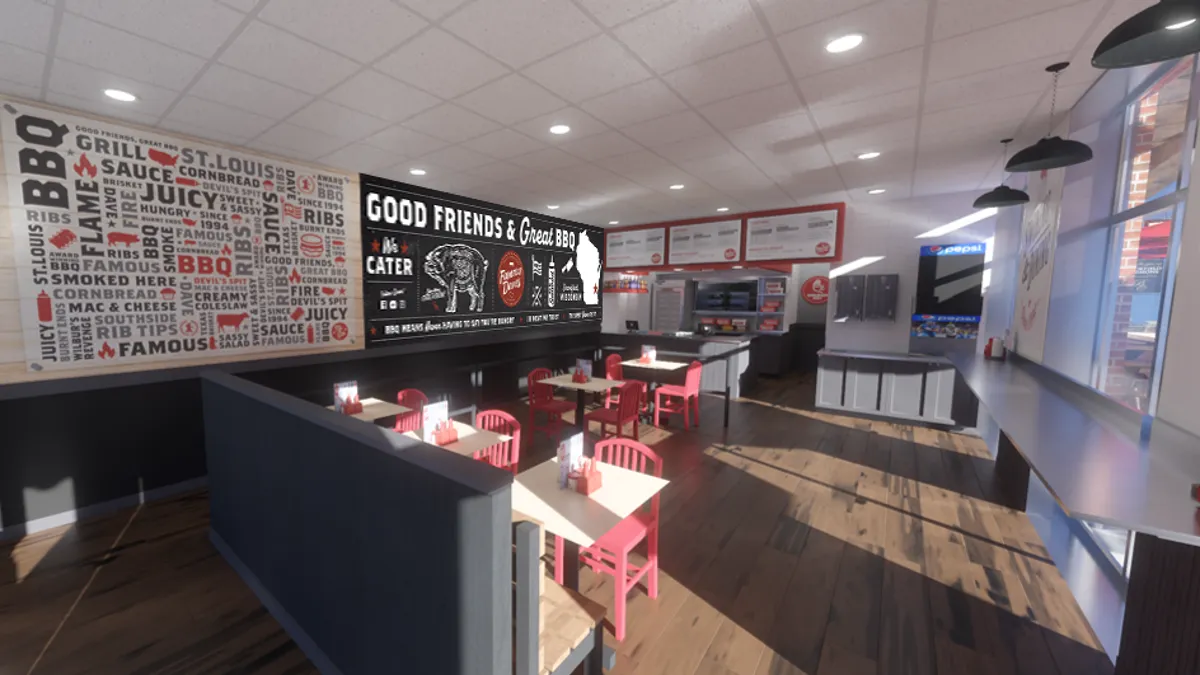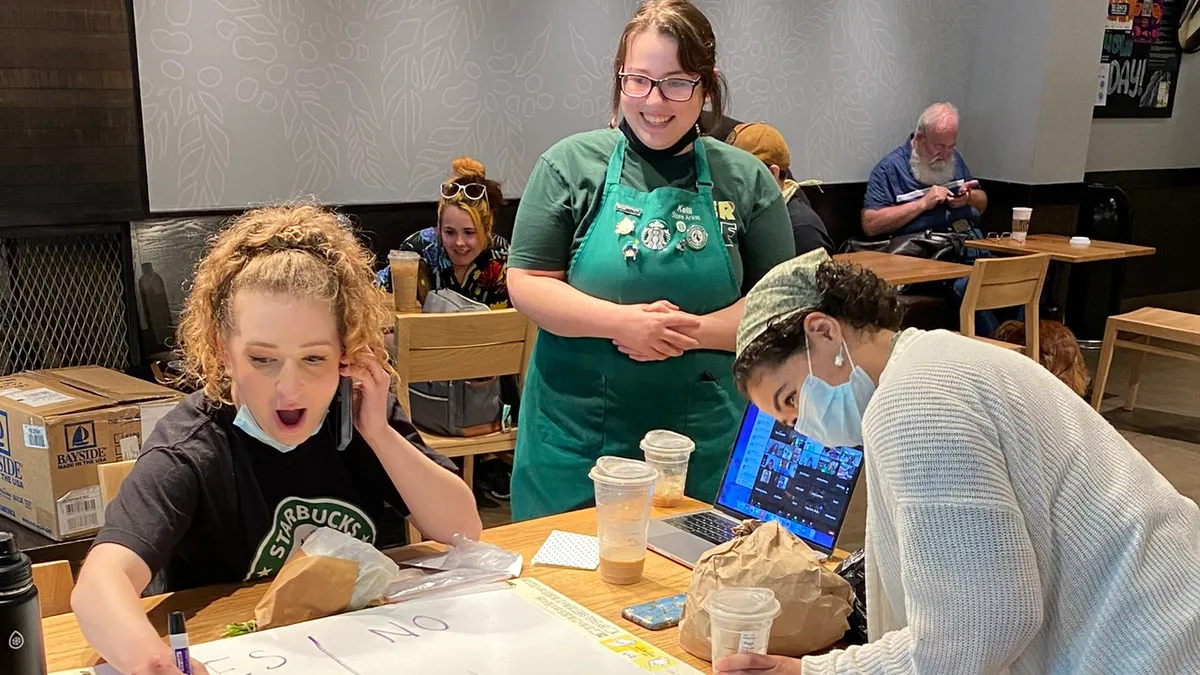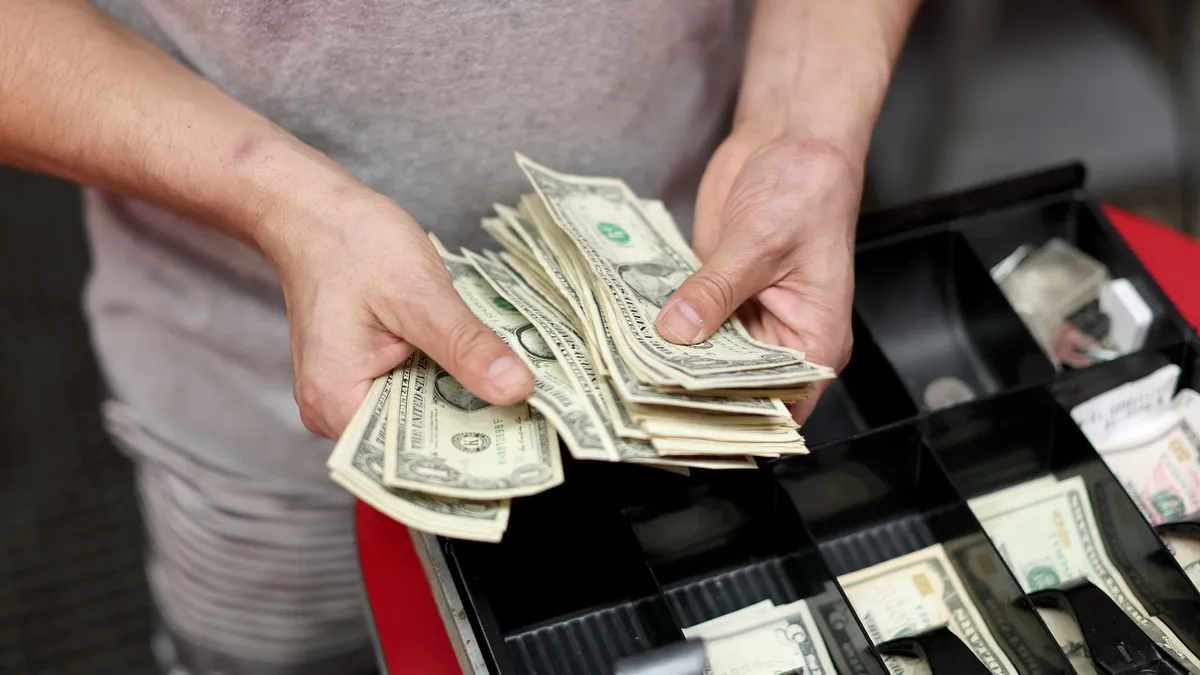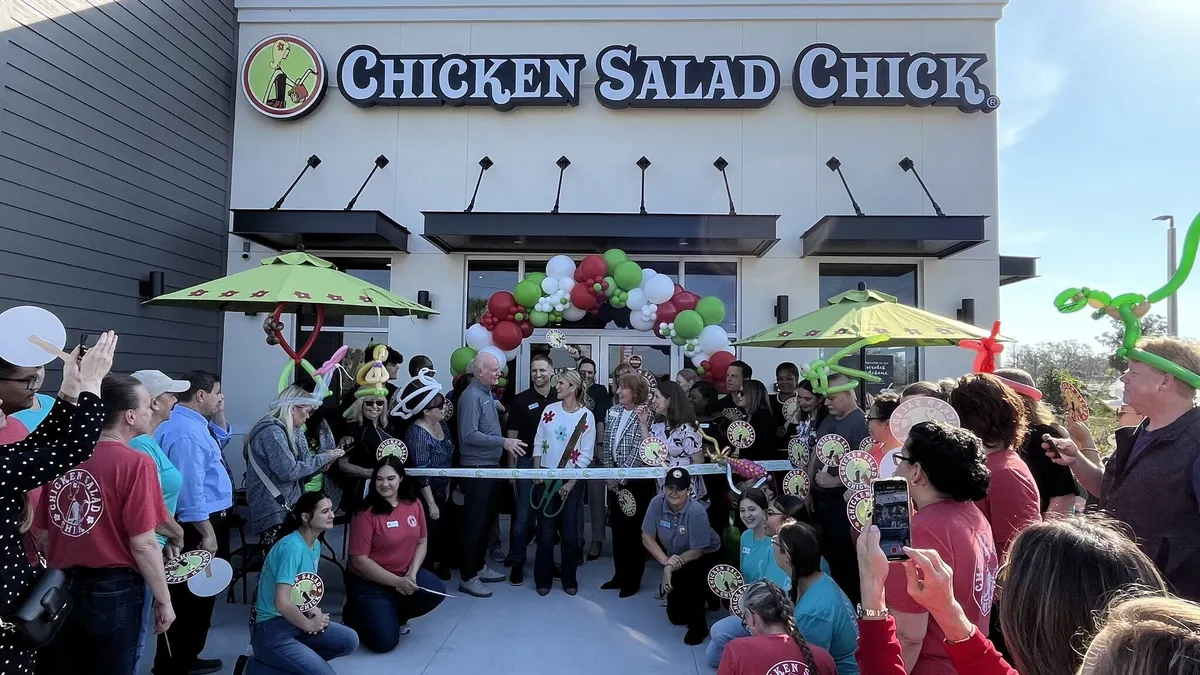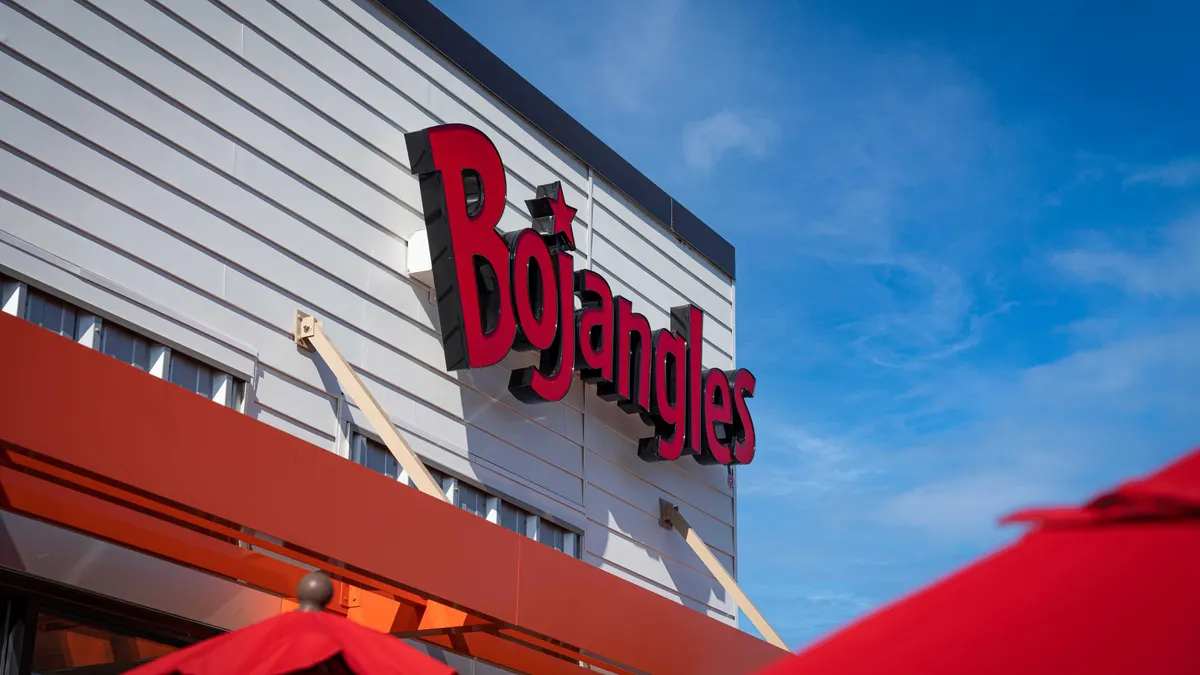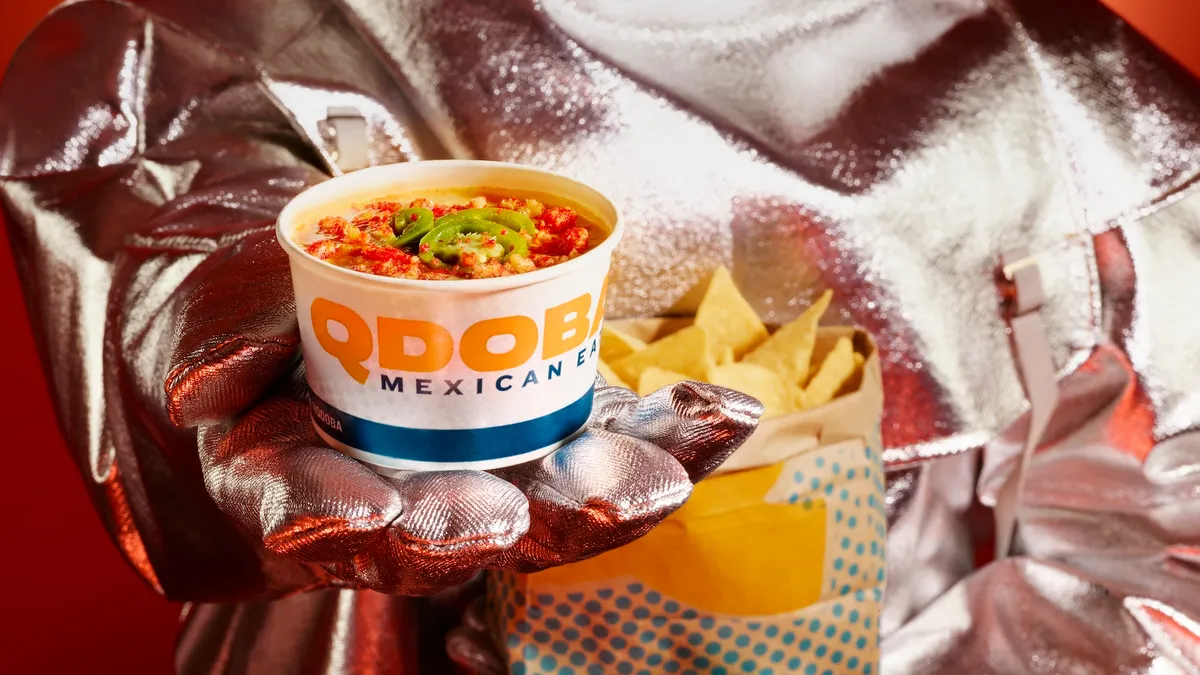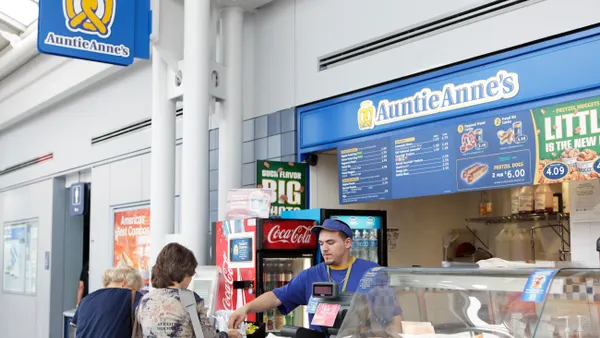Famous Dave’s BBQ is working to make its store smaller to keep up with consumer demand for off-premise dining and fast service. The brand is shrinking its dining room, eliminating the full bar and setting up counter service for small stores.
The prototype is the culmination of a design process going back before the COVID-19 pandemic, said Al Hank, chief operating officer at parent company BBQ Holdings. The first restaurant built according to this model opened Thursday in Brookfield, Wisconsin.
“The ideation probably started back in 2018,” Hank said. “We've launched a couple different iterations over the last couple years, really working to find the right model with the right unit economics that are competitive in today's landscape.”
Those early tests included line service and drive-thrus in layouts ranging from 1,200 to 3,600 square feet — significant changes from the brand’s 6,000 to 7,000-square-foot, full-service models. But neither line service nor drive-thrus proved essential, and the Brookfield unit synthesizes the lessons of these previous prototypes. The new prototype, designed to fit in spaces from 1,500 to 3,000 square feet, marks a return to the brand’s first stores, which featured a counter-service model.
Hank spoke to Restaurant Dive about how the new prototype changed the brand’s development strategy, and what the 112-unit chain is looking for next.
Editor’s Note: This interview has been edited for clarity and brevity.
RESTAURANT DIVE: What sets this prototype apart from pre-2018 restaurants and past models that share similar design philosophies?
AL HANK: Pre-pandemic, the business had started to evolve pretty dramatically. If you go back to the heritage of the brand, 30 years ago, most restaurants were all built with a dedicated takeout area and entrance. To-go had always been a big philosophy of the brand. Pre-pandemic we were doing between 35% to 40% of our revenue off-premise. Post-pandemic, that number is more like 55% to 60%.
The historical Famous Dave’s restaurant model is somewhere between 6,000 and 7,000 square feet and 220 to 240 seats, with a heavy emphasis on dine-in traffic. As the consumer has changed their behavior, we've continued to evolve the prototype’s design, footprint, layout, model, etc.
Through the last couple of prototype iterations, we've tried things like drive-thru and line service. And in reality, if you look back to when Dave Anderson started building his second and third restaurant after the original one in Hayward, Wisconsin, he had built them as a counter-service model, sometimes referred to as a shack internally. You walk up, place your order, get a number and the food is delivered to your table, or you're taking the food to go. Units two through 10, roughly, were built like that. Then we changed and evolved to add full-service bars and add other components, like a host stand, and actually turn them into full-service restaurants.
We've been laser-focused on making sure that our upfront initial investment and the capital allocation needed to open one of these new restaurants is significantly less than traditional units. We're targeting somewhere in the neighborhood of roughly $600,000 to build out one of these smaller footprints, which is a fairly material shift of the historical minimum builds, it’s probably about $1 million dollars less.
What elements have been removed in this prototype compared to the larger, full-service models?
Certainly a pretty hefty reduction in the seating area. These new prototypes don't have a full-service bar. We’re predominantly just doing packaged beer and wine. Certain pieces of the kitchen are a little bit smaller.
But the menu is obviously not the same large, robust menu you have in the full-service restaurant. It's back to the core of what Famous Dave’s was founded on: ribs and brisket and chicken and pork. We've also still got other elements, like salads and burgers that are high-demand, high-mix items.
We removed some of the dishes like salmon. We've reduced the amount of burger offerings, or certain sandwiches.
How else does the prototype reduce costs?
Equipment technology has come a long way in the last decade. We certainly have found new uses of equipment. With reduction of certain menu items, you can streamline some of the equipment needed. And, obviously, the overall size of the restaurant and fewer tables has certainly reduced the cost of building out one of these.
What type of real estate does this open up, relative to previous versions?
Historically, we did a lot of free-standing buildings. This prototype gives us quite a bit of flexibility in the multi-tenant space, predominantly endcaps. We haven't really tested an inline space thus far, but we really like the idea of endcap locations.
This restaurant in Brookfield, Wisconsin, is a site we took over from a former Starbucks and it has a patio area, too. We like the patios because in the appropriate weather, we have six to seven picnic tables out there. So it provides us with some seating and some other options during the summer months.
When you're in a multi-tenant building, typically the operating costs are significantly reduced.
Does this unit have a drive-thru, and do you plan for future developments to have drive-thrus?
This one does not.
It's not a deal breaker for us. We don't need that in order to execute. In one of our units, we did test drive-thru. And predominantly, the Famous Dave’s consumer just used it as more of a convenience thing. A drive-thru for us is probably more of a pickup window versus a traditional ordering type experience.
We didn't see any significant change in ordering incidents. It didn't really have any material shifts in the business. With drive-thru still being in super high demand, in the overall real estate marketplace, it's certainly not a deal breaker for us.
What types of real estate categories and markets are you targeting?
We've certainly received quite a bit of interest from external franchisees. We signed a deal last year to open up three units of the new prototype in Atlanta. We're close to leasing our first unit there.
The new prototype is allowing us to infiltrate new markets. And then we've also got an existing base of franchisees that this allows to expand a little bit more effectively and efficiently.
From the pure economics of cash-on-cash returns, and our ability to really pump these out, it'll give us a lot more flexibility to enter markets.
We've got some interest right now in Delaware. We think there's more opportunity in Wisconsin, specifically the Milwaukee area. And there's a couple other marketplaces around the country — Arizona — that we've certainly been looking at.
Do you intend to use this prototype for all your development going forward?
I wouldn't say that we're limiting ourselves to the new prototype. Certainly, the appetite of our franchisees has been skewed a little bit more to the smaller box and the new prototype.
However, there's still others interested in building full-service restaurants; it's certainly not something that we want to stray away from.
We just think that the square footage of a full-service unit should be probably in that 4,500-to-5,000-square-foot range, versus the traditional 6,000 or 7,000-plus square feet, based upon the way that the consumer interacts with the brand. Today, we certainly can have 100 to 150 seat dining rooms; I don't think we need 250 seats in the box.
Do you have a target unit count in mind given how much new space this opens up?
The growth horizon over the next five years looks pretty good. We'll be opening anywhere from two to six of these units this year. I think it can ramp as we get a little bit more data as we open up the first two.
Like I said, we got the three units in Atlanta. We’ve got this one right now in Brookfield, and we've got some other development opportunities. But I think somewhere in the two to 10-unit range annually is probably right over the next couple years.



